Product Requirements:
Desktop:
486 or better PC, or Macintosh
Windows 98/95 or NT 4.0
HandEra might not be a company that
you’re familiar with, but I think it soon will become a very popular name. At
least I hope it does! Formerly known as TRG, they developed the TRGPro Palm PDA which
was the first Palm PDA with a built in Compact Flash slot. Now as HandEra, they
have just released what I consider to be the ultimate Palm OS mono PDA to date.
The 330 has almost every feature from all the previous Palm OS PDAs, and then for good measure they throw in a few extra cool tidbits that no one else has.
Let’s check out the hardware specifications first.
Hardware Specs:
Operating System: Palm OS version 3.5.2
Processor: 33 MHz Motorola Dragonball VZ
Memory: 8 MB (2MB Flash ROM + 8MB RAM)
Display: 240 x 320 pixel 16 Gray scale – Active area 2.2 x 2.9 in. (55 x 73
mm)
Size: 4.7 x 3.2 x 0.7 in. (121 x 81 x 17 mm)
Weight: 5.9 oz. (167 g) with AAA alkaline batteries
Infrared port (lrDA v1.2) up to 115k baud
One CompactFlash™ Type I/II card slot
One Secure Digital (SD) or MultiMediaCard slot
Serial Cradle
Battery: 4 AAA’s
I’ll admit that I wasn’t all that jazzed about doing this review at the beginning.
Having just come off of doing the Palm m500
and m505 within the space of a couple days, I was experiencing a little review burnout.
When I opened the HandEra 330 box and got my first glimpse of this new unit, I
thought there had been a mistake and somehow a Palm IIIc was put in the box
instead. I thought this because the 330 has a black flip cover that looks
exactly like the IIIc flip cover. Then I flipped the cover open and my burnout
faded away in a puff of smoke.
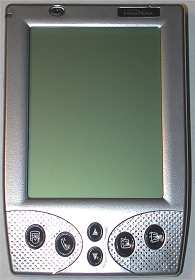
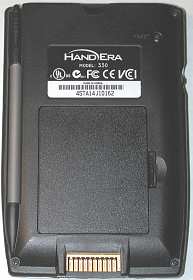
The first thing I noticed was the silver case. I can’t tell if it is silver
painted, or if that is the color of the plastic. It’s actually just the front
half of the PDA that is silver. The back is black. The case is very solid and
doesn’t creak, crack or flex when you squeeze it. The 330 is actually almost
identical in size and weight to the Palm III series PDAs. It feels comfortable
and familiar (if you’ve ever had a Palm III series PDA) in your hand. The great
thing about the 330 is that it has the same notches at bottom that Palm III
series PDAs have. So, you can use the 330 with the any accessories that are
compatible with the Palm III.
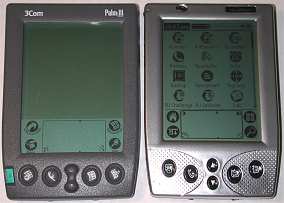
As for cases, the HandEra will fit in any Palm III series case, but the buttons
on the left side of the unit will probably be covered.
The front of the 330 has the power button, battery charger / alarm LED,
application buttons, and microphone. The power button is a small hard oval
dimpled button that clicks when pressed. I found it a little awkward to press
because of its size and location. Holding down the power button for a few
seconds toggles the backlight. More about that later.
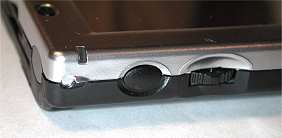
The battery charger / alarm LED blinks green while charging the optional
lithium battery pack (lithium batteries and charger are not included) and then
glows steady when the charging is complete. This LED will also blink red when
you have an alarm. By adjusting the system preferences, you can use this LED as
a silent alarm while in meetings or other places that you don’t want an audible
alarm to be sounded. The LED is viewable when the flip cover is open or
closed.
The application buttons are black concave plastic buttons that have very good
tactile feedback. The buttons are large and are easy to press. The scroll
buttons are separate Up / Down buttons that are also easy to activate.
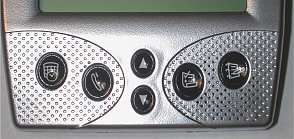
The speaker is at the bottom right of the PDA near the Task and Memo
application buttons. The 330 speaker seems to be louder than any Palm device to
date! Not to mention the fact you can listen to .WAV files and play DTMF tones
(dial tones). I was able to successfully dial a phone number using a third
party tone app.
The microphone for the voice recorder is located above the HandEra logo. The
voice recorder activation button or auxiliary button is the top most button
located on the left side of the PDA. Pressing and holding this button in when
the 330 is off, will power the unit on, launch the Voice Pad application and
will record your memo. Letting go of the button will cease the recording. One
bad thing about the flip cover is that it covers this button when it is closed.
The voice recorder does a fair job. As long as you speak within a few inches
from the mic, the recordings sound clear and audible. More than a foot or so and
they will be too soft to hear. Recordings are 8 bits, mono sampled at 8000. You
can’t change these settings. I found that a 5 second memo requires about 40K of
storage. The Voice Pad app allows you to save the recordings to CF, SD/MMC or RAM.
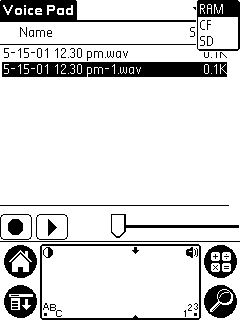
You can even listen to .WAV files using the Voice Pad or CardPro applications.
It’s not the same as listening to .MP3s, but it looks like it’s as close as we’re
going to get until the color Sony Clie comes out.
The auxiliary button can also be used to turn the PDA on by just pressing
it once. I actually thought this was the main power button at first till it wouldn’t
turn the unit off. When the unit is on, it can be used as an ESC button to return
you to the main menu or to cycle thru the application launcher categories. By
changing the system settings, you can also assign an application to this button
so that when you press it and hold it, it will launch that app. The one press
setting can be changed to make the button function as an Enter, Contrast, Volume
or Beam Data button.
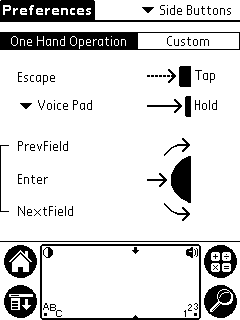
The jog wheel is located under the auxiliary button. This button is spring
loaded and can rock up and rock down and press in. It is just like the
action rocker button that Casio uses on their
Pocket PCs. What can you do with this button? Well, you can use your 330 one
handed for apps like the Address book and Datebook. So for example, you
can press the auxiliary button once to turn the unit on. Then use the jog wheel
to select the Address book app (as you rock the jog wheel up and down, a box
will display around each app as you move the wheel). When the Address book is
selected, you can then press the jog wheel in and it will launch the app. Then
you can use the jog wheel to cycle up and down thru the entries. Pressing the
jog wheel in will bring up the details on that entry. You can then press the
auxiliary button to exit out of that record and back to the address list view.
Pressing it again will then exit out of the Address Book and put you back into
the application launcher screen.
Towards the bottom of the left side there is the AC adapter connector for a
120- Volt AC adapter (available separately). You can also connect a auto adapter
so that you can power the 330 from the cigarette lighter in your car.

While we’re on the subject of power, the 330 uses 4 AAA batteries. They can power the unit for approximately twice as long as other Palm devices. An optional
removable lithium ion rechargeable battery pack will also be available in the near
future.
The top of the unit has the IR port. I was able to beam addresses back and
forth to the 330 from an m505 at almost 6ft.

The top also has a Compact Flash card slot and an SD card slot. The CF slot supports Type I and Type II cards (including the IBM Microdrive). I found the CF cards easy to slide in and out of the PDA.
I tested several cards for compatibility and found that the 330 didn’t like any
of my Lexar cards. But my Kingston and Sandisk cards worked fine.
Two applications are included with the 330 that help you manage your memory cards. One is called CardPro and is a very comprehensive app that allows you to copy, move, and delete files from RAM, CF or SD/MMC. It will also allow you to format CF and SD/MMC cards. It is very similar to your file manager on your PC.
The other program is called Backup and it does exactly that. It backs up all your data to either CF or SD/MMC cards. And it is FAST. It can backup 7.3MB of data in about 15 seconds and restore the same amount in 30 seconds! This is a very nice program because it allows you to save multiple backups that are time and date stamped. You can also renamed the backups to whatever you want. And, you can view individual databases inside the backup and just restore the ones you want.
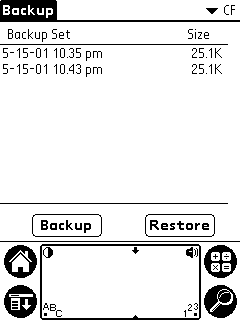
The SD slot supports SD and MMC memory cards. Cards pop in and out via the spring loaded
slot.
Having two different media slots is very nice because you can use the SD/MMC slot for memory storage and keep the CF slot for a modem or other
peripheral.
Unfortunately, there is a gotcha with using the memory cards with the 330. You can’t
automatically run applications from the cards like you can on the Palm m500 / 505.
However, you can download a free OS extension from HandEra called AutoCF.
It will allow you to run apps from the CF card. The apps will show up in the regular app
launcher with a small square beside them. This program won’t work with SD/MMC
cards though. A new version called AutoCard is in the works which will
allow both CF and SD/MMC cards the ability to have programs run from them. Also,
as soon as HandEra is able to update the 330 to Palm OS version 4.0, the ability to
run programs from the memory cards will be built-in. So, as it is right now, all
the pre-loaded Palm SD cards that you can buy for the m500 series PDAs, will not
work on the HandEra. You can see the files, but you can’t run them from the SD
card.
The back of the unit has the reset switch, stylus silo, battery compartment and
hotsync port. The reset switch is nice and large. You won’t have to fish around for a paper clip or unscrew your stylus to get a pin to activate it. It’s large enough that you can just poke the end of your stylus into the hole.
The stylus silo accepts any Palm III compatible stylus. The stylus included with the 330 is the same metal barrel, plastic ends type stylus included with other Palm PDAs.
The battery compartment houses either 4 AAA’s or a lithium ion battery pack. The packs aren’t available as of the time of this review.
The hotsync port will be a welcome sight to people that are upgrading from the
Palm III series PDAs. It uses the same connector. So, all your same accessories,
cables and cradles will work fine with the 330.
Speaking of the cradle, the 330 is just a black Palm III cradle with the
HandEra logo. The bad thing about it is that it is serial instead of USB. USB
is much faster but I guess the trade off was either changing the hotsync connector
to enable USB, or sticking with the tried and true serial syncing and compatibility with
older peripherals.
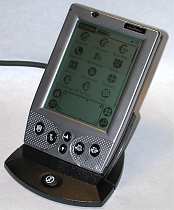
The most exciting feature of the HandEra 330 has got to be the display. Although
it isn’t color, it is still very cool. Why? Because the graffiti area is not static
like all other Palm OS devices. Instead, it is software based and can be shrunk out
of the way in order to take advantage of all the available screen real estate. No
more 160 x 160 pixel constraints. The 330 screen is 240 x 320 pixels in size which
is the same as all current Pocket PCs on the market.
The actual display is very similar to my Palm V. It has the same greenish background color.
The text is black, sharp and easy to read in a variety of lighting conditions. Outside in direct sunlight, the screen is perfectly easy to read. Indoors in low light, you can turn on the backlight for easy viewing. And guess what? The backlight is the old style! It’s not
the “reversed and otherwise useless” version that newer Palms use. That in itself is grounds to celebrate!
The graffiti area like I said before, is no longer static. If you want to use the whole
screen, you can shrink it by pressing a small arrow. Then when you need to use it again,
you can press the arrow to pop it back up. Another really nice feature is that your
graffiti strokes are echoed on the screen. You can now see exactly what you’re trying
to write! I love this feature! The graffiti area also has two small icons that when tapped will popup either the volume slider or the screen contrast slider.
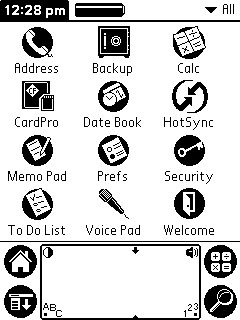

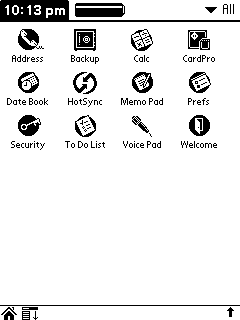
Some people might say, "what’s so cool about a shrinking grafitti area.
Well, the cool part is that some programs will automatically fill the open area
giving you more viewable info. For example, memo pad entries can fill the
screen, the address book app can fill the screen, some ebook readers such as
TealDoc and AportisDoc to name a few. Programs that don’t fill the screen just
use the top half. All the built-in applications also now can have your choice of
8 different fonts. Some programs even allow you to rotate the screen which is
nice for ebook reading.
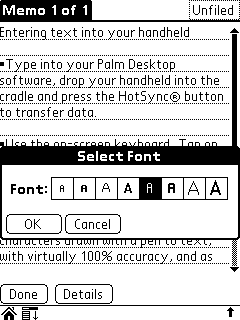
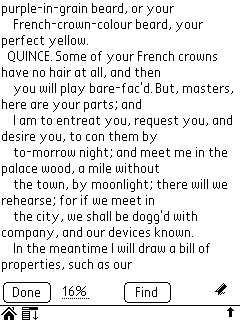
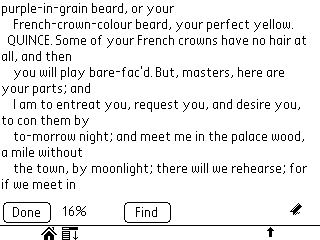
The 330 does have a few problems with compatibility. Of the programs that I
tried, the ones that I had problems with were PhotoSuite, Screenshot Hack, Wave
Player and MTI Audio Player. The WAV players didn’t make any sounds at all. It
was like they were on mute. Although they were made for the TRGPro, I guess
there is still enough difference in the 330 so that they didn’t work. The screen
programs scrunched everything up to the top .5in of the screen. I was able to
get TealMovie to work fine, but the sound wouldn’t play. Any program that writes
directly to the screen memory will probably have problems until they are updated
for the 330’s screen.
I’m really happy with the display on the 330. After having used it for several
days, I can’t stand going back to the regular Palm screen with the static
silkscreened area. It makes me feel cramped. I sure hope future Palm devices
adopt this same great feature.
Speedwise, the 330 is snappy and fun to use. It actually rates the highest of
all Palm OS devices to date according to Neal Bridges Benchmark
program (v2.0). Check out the numbers below:
| Palm V | m100 | m500 | m505 | Visor Prism | 330 |
| 91% | 91% | 154% | 156% | 205% | 244% |
Now let’s take a look at the software side of the HandEra 330.
The 330 comes with the same built-in PIM apps in ROM that every Palm OS
devices has. The additions to the ROM apps are the Backup, CardPro and Voice Pad
apps.
The PDA also comes pre-loaded with a bunch of apps that have been enhanced to
take advantage of the larger screen. These apps are all demo versions of popular
shareware titles such as:
Seahorse Software card games: Euchre, Crazy 8’s, Pyramid Solitare, etc
AportisDOC doc reader
Mapopolis mapping software
BigClock world clock application
and quite a few others.
You also get the registered version of Cutting Edge Software’s Quickoffice.
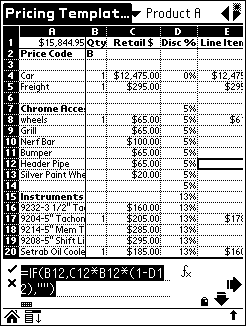
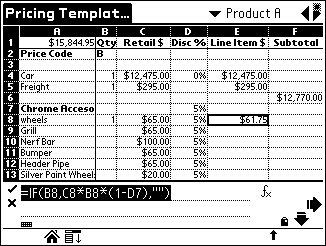
I think the HandEra 330 is a fantastic mono Palm device. I’ve actually given
it the nickname of FrankenPalm. It has the jog dial from the Sony Clie, the
voice recorder from a Pocket PC, the Compact Flash slot from the TRGPro, the
SD/MMC slot from the m505, and the hotsync connector from the Palm III. If you
want a mono Palm device, this is THE one to get. HandEra really did their
homework on this device. And the price is terrific when you consider all the
great features that are built-in.
Price: $349.99
Pros:
Can use the full screen
Compact Flash and SD/MMC slots
Able to use Palm III periphreals
Voice Recorder
Jog Dial
Cons:
Mono screen
Can not run applications from SD/MMC cards
Gerber Gear Suspension 12-in-1 EDC Multi-Plier Multitool with Pocket Knife, Needle Nose Pliers, Wire Cutters and More, Gifts for Men, Camping and Survival, Grey
25% OffGerber Gear Diesel Multitool Needle Nose Pliers Set, 12-in-1 EDC Multi-Tool Knife, Survival Gear and Equipment, Black
$129.99 (as of December 11, 2025 18:03 GMT -05:00 - More infoProduct prices and availability are accurate as of the date/time indicated and are subject to change. Any price and availability information displayed on [relevant Amazon Site(s), as applicable] at the time of purchase will apply to the purchase of this product.)Product Information
| Price: | 349.99 |
| Manufacturer: | Handera |
| Pros: |
|
| Cons: |
|



Gadgeteer Comment Policy - Please read before commenting
Julie,
Just thought you should know that Vaja has a nice selection of cases for iPOD’s.
They have a version for the 30GB iPOD in the works according to their site. I’m not sure if the current cases would work with the 30GB version or not…
Anyway, you might want to check them out…
Kind Regards,
Christopher Spera
Hi Chris,
I’ll be sure to keep an eye on Vaja for their new iPod cases. I don’t think their current versions would work well with the latest models due to the new buttons above the touch pad.
I would also point you toward the iPod Armor. http://www.halfkeyboard.com – the case is $49.00 – but the reviews I have read suggest that it makes your iPod pretty bomb proof. It’s aluminum / a neoprene lining – tight fit (according to the reviews) but it can take a drop to concrete w/ no problems. Completely covers everything but the top ports – so you are stuck w/ the remote for navigation (or opening it each time you wanna change)
I have a 15gb Ipod and am using the new case from waterfield bags. It is great gicing access to both to and bottom as well as having a flip to for access the buttons. In addition it comes with a removeable belt clip. Also bought the small gear bag to hold my headphones, remote and firewire cable so they do not get lost in the void, that is my bag.
http://www.sfbags.com
What a coincidence, I just received my iPod case from Waterfield as well (i ordered a blue one for myself and a red one for my wife’s … we have matching 15GBs) as well as a medium gear bag for my firewire cables, Powerbook cords, wireless mouse, etc.
I’m putting my case through its paces right now and noticed that it’s a little difficult to access the Hold button through the slit on the top. But on the positive side, with the protective flap, there’s very little chance of accidentally pressing a button or moving the dial, so no real need for the Hold button anymore. And I love the inside flap for earphones storage – no more winding my earphones around the case and then invariably losing a foam earpiece off one of the buds. (I’m on my third set!)
Am extremely pleased with their product and service, and am quite impressed that it got to me in only 3 days from San Francisco, halfway around the world. Give them a try!
This is a very nice PDA, the speakers make the purchase well worth it, even in 2017!